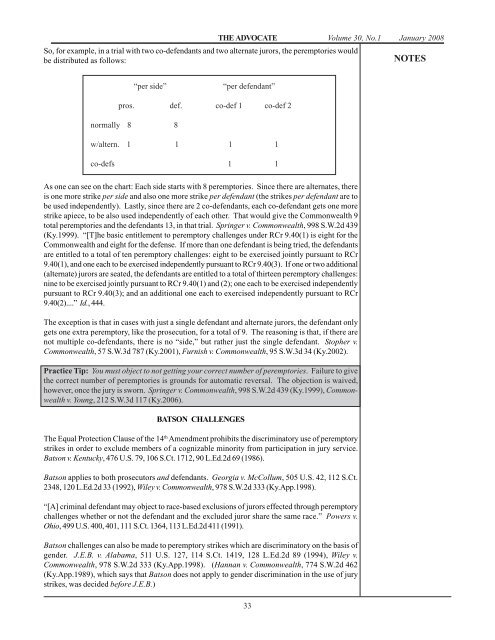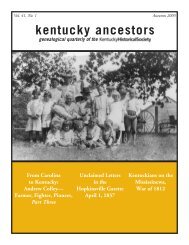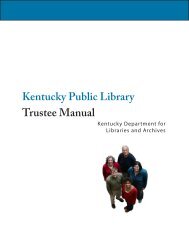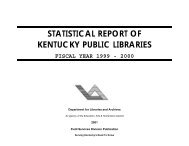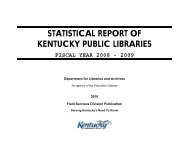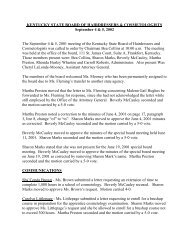Jan08 Advo.pmd - e-archives Home
Jan08 Advo.pmd - e-archives Home
Jan08 Advo.pmd - e-archives Home
Create successful ePaper yourself
Turn your PDF publications into a flip-book with our unique Google optimized e-Paper software.
THE ADVOCATE Volume 30, No.1 January 2008<br />
So, for example, in a trial with two co-defendants and two alternate jurors, the peremptories would<br />
be distributed as follows:<br />
“per side” “per defendant”<br />
pros. def. co-def 1 co-def 2<br />
normally 8 8<br />
w/altern. 1 1 1 1<br />
co-defs 1 1<br />
As one can see on the chart: Each side starts with 8 peremptories. Since there are alternates, there<br />
is one more strike per side and also one more strike per defendant (the strikes per defendant are to<br />
be used independently). Lastly, since there are 2 co-defendants, each co-defendant gets one more<br />
strike apiece, to be also used independently of each other. That would give the Commonwealth 9<br />
total peremptories and the defendants 13, in that trial. Springer v. Commonwealth, 998 S.W.2d 439<br />
(Ky.1999). “[T]he basic entitlement to peremptory challenges under RCr 9.40(1) is eight for the<br />
Commonwealth and eight for the defense. If more than one defendant is being tried, the defendants<br />
are entitled to a total of ten peremptory challenges: eight to be exercised jointly pursuant to RCr<br />
9.40(1), and one each to be exercised independently pursuant to RCr 9.40(3). If one or two additional<br />
(alternate) jurors are seated, the defendants are entitled to a total of thirteen peremptory challenges:<br />
nine to be exercised jointly pursuant to RCr 9.40(1) and (2); one each to be exercised independently<br />
pursuant to RCr 9.40(3); and an additional one each to exercised independently pursuant to RCr<br />
9.40(2)....” Id., 444.<br />
The exception is that in cases with just a single defendant and alternate jurors, the defendant only<br />
gets one extra peremptory, like the prosecution, for a total of 9. The reasoning is that, if there are<br />
not multiple co-defendants, there is no “side,” but rather just the single defendant. Stopher v.<br />
Commonwealth, 57 S.W.3d 787 (Ky.2001), Furnish v. Commonwealth, 95 S.W.3d 34 (Ky.2002).<br />
Practice Tip: You must object to not getting your correct number of peremptories. Failure to give<br />
the correct number of peremptories is grounds for automatic reversal. The objection is waived,<br />
however, once the jury is sworn. Springer v. Commonwealth, 998 S.W.2d 439 (Ky.1999), Commonwealth<br />
v. Young, 212 S.W.3d 117 (Ky.2006).<br />
BATSON CHALLENGES<br />
The Equal Protection Clause of the 14 th Amendment prohibits the discriminatory use of peremptory<br />
strikes in order to exclude members of a cognizable minority from participation in jury service.<br />
Batson v. Kentucky, 476 U.S. 79, 106 S.Ct. 1712, 90 L.Ed.2d 69 (1986).<br />
Batson applies to both prosecutors and defendants. Georgia v. McCollum, 505 U.S. 42, 112 S.Ct.<br />
2348, 120 L.Ed.2d 33 (1992), Wiley v. Commonwealth, 978 S.W.2d 333 (Ky.App.1998).<br />
“[A] criminal defendant may object to race-based exclusions of jurors effected through peremptory<br />
challenges whether or not the defendant and the excluded juror share the same race.” Powers v.<br />
Ohio, 499 U.S. 400, 401, 111 S.Ct. 1364, 113 L.Ed.2d 411 (1991).<br />
Batson challenges can also be made to peremptory strikes which are discriminatory on the basis of<br />
gender. J.E.B. v. Alabama, 511 U.S. 127, 114 S.Ct. 1419, 128 L.Ed.2d 89 (1994), Wiley v.<br />
Commonwealth, 978 S.W.2d 333 (Ky.App.1998). (Hannan v. Commonwealth, 774 S.W.2d 462<br />
(Ky.App.1989), which says that Batson does not apply to gender discrimination in the use of jury<br />
strikes, was decided before J.E.B.)<br />
33<br />
NOTES


